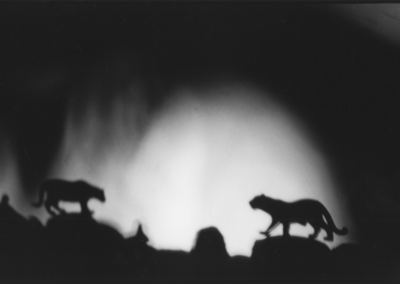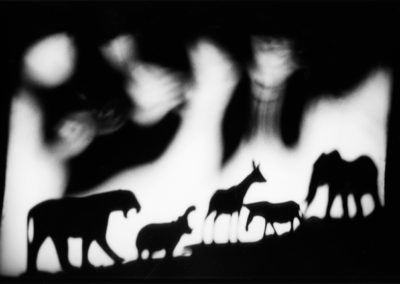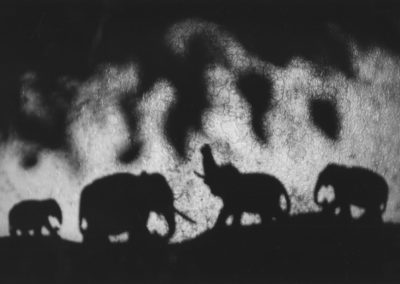I THINK CHRISTOPHER FELVER is involved in the tug of war between a certain kind of minimalism and post minimalism. In this fugue, Chris creates something that is very wide in terms of its scope. You suddenly see something that looks like a gigantic presence of shadows; you see things that are pulling (falling) apart like a Joseph Cornell; you see clean rows of objects like an Andy Warhol; and very classic beauty. It’s very elegant and much of it a spiraling situation.
Fernand Léger was the only person who loved technology so much that he enjoyed the first World War. Let’s hope that’s not true, but I think that what’s interesting [in the Ordered World photographs] is that these twin trees are expertly handled but then suddenly [Felver] can get that kind of beauty in a little piece of a branch, a little non sentimental sign, almost a “velleity” or little wish. And then something that looks like a dark sketch for the apocalypse. So all of these are very interesting structurally but they shouldn’t be thought of as simply structures. They are architectural thoughts. And someone might not want to call them sculptures but structures also as a lyrical poetry long poem.
What is interesting for me is how stable some parts of these images are. He tends to have one quarter this, one Zen willingness, drastic diagonals. Not so stable. A window is an archway and a window. Something else may look art deco, but I think that what’s important is something that Charles Rosen said, which is, “that the classical style of music is not about harmony but it’s about dissonance.”And actually that is part of what makes Chris’s work so beautiful. I have in my hands some nude photographs and they do have this Russian structure, this situation. But they are also montages, cinematic. It just stands to reason that he has this camera eye of a Vertov who could shoot things backwards. One of the things about juxtaposing three different images is that it does have what a photographer once told me, “the beauty of adjacent slides, the beauty of adjacent energies, all those are things that make this as close to cinema as to any other art. And I think it’s very brave that he can use nature as much as other forces. And I guess to conclude, a lot of French philosophy the last twenty to thirty years, which “leaked into or downwardly drifted” into art criticism, was [expressed as] ideas of the undecidable.
So you can’t really say you can identify each in this collage. But you can’t really say why the beauty is so strong in adjacent frames. This is like a string trio. I remember when a lot of people, Jan Groover, Eve Sonneman, and others were experimenting with this, and I hope that they will continue researching this. But in a way Chris is already continuing to research that, these photographs propose themselves later, I think, as painting. Painting again with images and images that explode. As in Eric Fischl’s, “Subverted Sexualities.” So, I think it’s quite moving in the way these collages put one thing next to another thing next to another thing. To combat Hitler, Hannah Höch made photomontages that were called “Strange Beauty.” They were very shocking for the time. So I would say for our time these are shocking. Also, I don’t want to call them inevitable, but they are.
What is interesting to me about our conversations about art is that now Chris is in the terrain of fundamental simplicities that are not so simple. In other words, like montage, the opportunities are endless to use these fundamental images in his grid systems. All of this comes together as part of the science that almost holds them together.
Kenneth Snelson for years thought he had the image of an electron, people laughed at him because they said you can’t have an image of an electron. It’s a wave, it’s a particle, and they pooh-poohed him for a long time. About two to three years ago, the Scientific American ran an issue that was only about Kent Nelson, how someone who had discovered that this master of knots and grids and pressures, pretty much like Chris, was able to go from that to thinking up, well it wasn’t electrons, but it was one of the basic physiological patterns. So thinking about this as a short story is interesting. Godard said a good movie should relate to a short story, not to a novel. In questions of scale, these works can be blown up to six feet, it’s also true that it becomes a sort of mental task and pleasure if one’s closer to them or hovers over them like a doll’s house. I think a short story is good because it has a theme of abruptness. Where does it end? Suddenly. In Chekhov you don’t know where that short story is going to end. And I think in these sequences by Chris Felver you have the same sense that it may be an alphabet, as he’s put it. Or an infinity. It may be like counting the permutations. But you do get lost in this very elegant darkness, which Jasper Johns once said to me was “clear darkness.”
I think [art work is] an adventure. Probably anyone who really knows Chris’s work will see what needs to be called the “human unity.” It’s amazing to someone, how can you do a film about this, a short story with grids, something else with the very images of stacking? How can you move from one to another? Picasso was famous for doing classical in the morning, neoclassic in the afternoon and cubist lights at night. We see a lot of differences. So all of these works are about transitions and are transitional in the life of this philosopher-cameraman. And the one enduring material—he knows and remembers the details of objects that come from ‘X’ place, a Prague, a London. He knows that. But we are left bewildered, because it’s the alphabet before it’s put into words and paragraphs and books, and that alphabet is a very strange force.
I think that, in a way that the permutations in Felver can go on forever, that the montages themselves are forever. One, two, three, it’s a very basic counting that Meyer Schapiro found in Van Gogh. Sky, wheat field, death, the crows. He calls that the “simple avoual” and says that the situation is an attempt to get toward the beloved object. Very often here we are thrust upon a surface, and in other places we are given deep enough shadow, so darkness is really the theme. I once spoke about the tradition of American darkness. We talk about the tradition of American light. I don’t really believe that Chris goes out looking for impressionist effects of light. I don’t see it in his work, anyway. I think what he does do is to use elements like the alphabet again, which are really scripts and scripts for a script.
Once upon a time when I was afraid of airplanes, I told Claes Oldenburg that I was afraid of airplanes. We had different attitudes towards this. Oldenburg said to me that once upon a time he said to a steward, “Let me off.” They’ve often said to me, “We can’t let you out sir, we’ve taxied already.” And Claes told me that after he left a plane that had already taxied he started to do his soft numbers and words. And I said, “So, basic anxiety, infantile anxiety, led you back to the child’s world of the alphabet.”
One of the things about Chris Felver’s work is that he’s partly maintained a child’s view of the world as constantly shifting, and that is exactly the context of which I want to remind you. That is, “There is a language here. And when you look at all of his work together you realize that they are functioning like the ancient alphabets becoming, by themselves, agents of montage, agents of the short story, agents of a grid system. The grid system was thought to be scientific rebellion in the nineteenth century; it isn’t. “The grid system,” as Meyer Schapiro once said tome, “is an old story.” The grid system goes back to strewn mosaics in Rome and Pompeii. So, if you’re looking at this fresh child-like vigor, you might think it’s only that, but what’s staggering in Chris’s work is that he has so much assured, confident, elegant, virtuosity. He is professional, but we don’t like that word. “Even sophisticated is a sad word,” said Lionel Trilling. There is joy in Chris’s work, a little mania of joy. His joyful art doesn’t stop. And I think one of the reasons he’s gone towards joyful art is rarely stopping for artists of whining and pathos.
I think a lot of his greatest work—in the Donald Judd vocabulary—is to use a basic alphabet, not in a soup, but in a mosaic. I think these photographs are distinct but they can also come together. It’s a series, but it’s not a series. Moments of time? You cannot quite tell. One of the curious things about these photographs is “not to know.” Of course, with an artist like Chris, you can ask him the question, “What is this?” What does this mean? How are you doing this?” and he will give you an answer, but the answer is not a limit to his photography. The limit can only be seen in a special way, which we may call a divertimento. In many movements, Mozart considered how he could put together the complexities of the world in different textures: one fast, one slow, one fast, one slow. So, I think that what’s marvelous about Chris is that he’s able to take this thickness, this density, something that John Hejduk used to call compaction. He loved compaction. Ezra Pound said it was condensation. And he said, even in a foreign language, “dichtung=condensare.” The poetry that we love the most has, I think, been a very fresh revolution against mere functionalism, the art of money and the domination of money in our day. Here is work that was not merely “commissioned”; though he can do commissioned work, these are largely self-commissioned. There is a self that commissions these images and wants to record. You can say, “But are you being specific enough about this particular work?” I think it would take many pages of a book to answer that, and I hope he will have his book, Ordered World, one day. Chris Felver has done many books of the naked face. Here are the naked grids or the clothed stacking. These are the systems that are efflorescent in his later work.
DAVID SHAPIRO . NEW YORK CITY . 2010
IN ORDERED WORLD, Christopher Felver celebrates the elemental essences of manmade and natural objects that tend to elude most people in everyday life. Felver’s aesthetic universe pits the obvious boundaries of architectural glass and steel against the more interior textures of nature, the glossy sheen of an industrial object or roughly stacked iron ingots in a foundry versus the grain of wood in a cross-cut tree or the curvature of a nude body. Ordered World recognizes the beauty of structure and likewise the underlying structure of beauty in a series of pictures that is remarkable both for its tightly honed cohesion and diversity of content.
Working in a manner not unlike Karl Blossfeldt, Albert Renger-Patzsch and the New Objectivity artists of 1920s and ’30s Germany, Felver asserts his own contemporary vision here. His pictures are informed by Minimalism and the keen, refined observation of a poet unwilling to discard the mundane or topical content that surrounds us but, nevertheless, is overlooked in the quickened pace of our technologically frenzied age. The series, while concerned with monumentalizing and focusing our attention on the ordered and structured surfaces of objects, resists any historical referencing to the hardened gaze of the twentieth century. It asks the viewer to ruminate on the overlooked beauty which surrounds us, the wonderment that unfolds, with careful and refined examination contained by specific moments in time.
As a series, Ordered World ranks Felver at the forefront of those exploring the photographic medium in today’s contemporary art scene. It is a testament to one man’s prescient eye.
JAMES CRUMP . NEW YORK CITY . 2006
WELL, I NEVER
would have expected your eye, Chris was so intent on
the form of the Line, and the Line
in the stillness of its movement
but of course
even in photography, you’re a son of Jackson, who gave Line new breath for all the arts,
so that even a sunshine-face-guy or see-me-in- my-most-sincere-loose-and–easy-snapshot-form like you — firing that camera away
at Beats anarchoids, jazzbeaus and the general rundown bohemia with its venerables of
post WWII and the Vietnam
War avant-gardes—also have
what zey call
in zee vernacular
a dizzyplin.
Most interesting, these shots. Yes, I’ve seen them like-so before other photographers
work in geometric form.
But this book’s grid-idea
is novel. Like a poem that tells one all one’s going to see
in short form and then
unfolds the enlarged fotos
so that one sees what the
artist is really after.
And what is that?
In works like this, perfection, of course. That’s the goal of geometric form, isn’t it? And the adventure
because nothing
of course is perfect,
Nor can anything be
perfect—thank godless—and so the silence that moves in abstract art and photography often evokes a very minimalist dimension, the sub-atomic particle-arity of a lost
or forgotten monumentality that physics
is trying to arrive at in the cosmos,
and mankind is trying to recover in its heart.
I like many of these works for their downright beauty of form, works with line and circle and spiral—also the exquisite haunch of a nude, and a shepherd
like a dignified christ
in his pasture, his cane held horizontally across his shoulders.
These last two are human forms
for that’s where you’re best
and what you find ,
and so you couldn’t have a book simply with un-human-being forms.
That would have been inhuman. There’d have to be what your fundamental
idiom works best with.
Though if an aesthetic monumentality
Is a goal, then certainly many of these fotos are evocative of images that
in shaping of artists like yourself
defy the ever encroaching banality
of image-cheapness
That dominates our time.
And if you ask me
well, then, yes, I think the final piece
of the third “chapter” of grids
in this book of Chris Felver’s
photographic short-stories
is one that is a truly visionary
and monumental work,
though it appears to be simply
the lines and edges of an opened paper or cardboard box, or a rock plateau of some breadth,
or Euclid’s rediant plane,
or the nuance of corners,
or the thirty other things evoked by
a perception of it.
In any event, it’s the recent event that’s most lifted me out of my MY and made me see all
the way in
to what you’re doing
to keep on being
open to whatever
comes along as long as
it’s in the mood and chiaroscuro of the Line of Light.
JACK HIRSCHMAN . 2004
ARCHEOLOGICAL PAPER
Christopher Felver has created a set of images drawn out of the widening world, chosen from the abyss, marked in obliterations of time and space down to hard substance that, even so, floats on air. These are mind prints likely to shout in the eyes of those who stand before them. Exuberance has here been handed down, focused. Fences, floors, European ceilings, slices of land that could be anywhere, luminations off a Latvian train, glints of marble and/ or human flesh; these are images plucked out of the earth, hammered onto brown rice paper by hard-working hands. The artist does honor to sight. He makes of the paper a marvelous ruin to be visited and revisited. As in a Zen garden we are made to recognize, not only the world surrounding us, but our own inner landscape as well.
NEELI CHERKOVSKI . SAN FRANCISCO . 2003
PULL-OFFS; CHRISTOPHER FELVER’S VANISHING MEDIUM
Christopher Felver was “thrown a pull-off ” when he finished first detaching the adhesive surface of a Federal Express mailing envelope. To his astonishment, he had discovered “images I had been looking for.” Long a renowned photographer of poets and artists, he has a keen poetic sense of chance and spontaneity as means to achieve surprising results. By photographic enlargements & prints of his original materials, there is revealed not only amorphous lines and forms but the presence of dynamic movement and multiple images. When first viewing these pictures, I immediately thought of certain dada and surrealist procedures such as Oscar Dominguez’s “Decalcomania With No Preconceived Object” which had been obtained quickly by spreading ink on a sheet of blank paper, pressing another sheet over it and peeling away. However, it turns out Felver has found a limited procedure since the company, Federal Express, discontinued using this type of envelope of which he now owns the last five hundred copies. It is because of this situation I suggest “pull-offs” may be seen as a vanishing medium. Felver’s interpretation is analogously significant: “They have an ancient cave art effect.”
PHILIP LAMANTIA . SAN FRANCISCO . 1998




